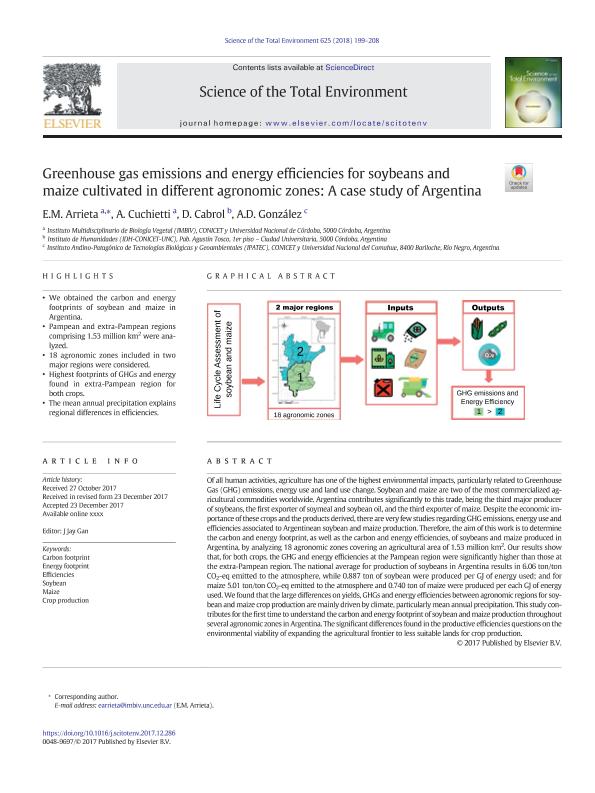Mostrar el registro sencillo del ítem
dc.contributor.author
Arrieta, Ezequiel Martín

dc.contributor.author
Cuchietti, Anibal

dc.contributor.author
Cabrol, Diego

dc.contributor.author
Gonzalez, Alejandro Daniel

dc.date.available
2019-10-24T18:06:46Z
dc.date.issued
2018-06-01
dc.identifier.citation
Arrieta, Ezequiel Martín; Cuchietti, Anibal; Cabrol, Diego; Gonzalez, Alejandro Daniel; Greenhouse gas emissions and energy efficiencies for soybeans and maize cultivated in different agronomic zones: A case study of Argentina; Elsevier; Science of the Total Environment; 625; 1-6-2018; 199-208
dc.identifier.issn
0048-9697
dc.identifier.uri
http://hdl.handle.net/11336/87223
dc.description.abstract
Of all human activities, agriculture has one of the highest environmental impacts, particularly related to Greenhouse Gas (GHG) emissions, energy use and land use change. Soybean and maize are two of the most commercialized agricultural commodities worldwide. Argentina contributes significantly to this trade, being the third major producer of soybeans, the first exporter of soymeal and soybean oil, and the third exporter of maize. Despite the economic importance of these crops and the products derived, there are very few studies regarding GHG emissions, energy use and efficiencies associated to Argentinean soybean and maize production. Therefore, the aim of this work is to determine the carbon and energy footprint, as well as the carbon and energy efficiencies, of soybeans and maize produced in Argentina, by analyzing 18 agronomic zones covering an agricultural area of 1.53 million km2. Our results show that, for both crops, the GHG and energy efficiencies at the Pampean region were significantly higher than those at the extra-Pampean region. The national average for production of soybeans in Argentina results in 6.06 ton/ton CO2-eq emitted to the atmosphere, while 0.887 ton of soybean were produced per GJ of energy used; and for maize 5.01 ton/ton CO2-eq emitted to the atmosphere and 0.740 ton of maize were produced per each GJ of energy used. We found that the large differences on yields, GHGs and energy efficiencies between agronomic regions for soybean and maize crop production are mainly driven by climate, particularly mean annual precipitation. This study contributes for the first time to understand the carbon and energy footprint of soybean and maize production throughout several agronomic zones in Argentina. The significant differences found in the productive efficiencies questions on the environmental viability of expanding the agricultural frontier to less suitable lands for crop production.
dc.format
application/pdf
dc.language.iso
eng
dc.publisher
Elsevier

dc.rights
info:eu-repo/semantics/openAccess
dc.rights
Atribución-NoComercial-CompartirIgual 2.5 Argentina (CC BY-NC-SA 2.5 AR)
dc.rights.uri
https://creativecommons.org/licenses/by-nc-sa/2.5/ar/
dc.subject
CARBON FOOTPRINT
dc.subject
CROP PRODUCTION
dc.subject
EFFICIENCIES
dc.subject
ENERGY FOOTPRINT
dc.subject
MAIZE
dc.subject
SOYBEAN
dc.subject.classification
Ecología

dc.subject.classification
Ciencias Biológicas

dc.subject.classification
CIENCIAS NATURALES Y EXACTAS

dc.title
Greenhouse gas emissions and energy efficiencies for soybeans and maize cultivated in different agronomic zones: A case study of Argentina
dc.type
info:eu-repo/semantics/article
dc.type
info:ar-repo/semantics/artículo
dc.type
info:eu-repo/semantics/publishedVersion
dc.date.updated
2019-10-23T15:10:15Z
dc.identifier.eissn
1879-1026
dc.journal.volume
625
dc.journal.pagination
199-208
dc.journal.pais
Países Bajos

dc.description.fil
Fil: Arrieta, Ezequiel Martín. Consejo Nacional de Investigaciones Científicas y Técnicas. Centro Científico Tecnológico Conicet - Córdoba. Instituto Multidisciplinario de Biología Vegetal. Universidad Nacional de Córdoba. Facultad de Ciencias Exactas Físicas y Naturales. Instituto Multidisciplinario de Biología Vegetal; Argentina
dc.description.fil
Fil: Cuchietti, Anibal. Consejo Nacional de Investigaciones Científicas y Técnicas. Centro Científico Tecnológico Conicet - Córdoba. Instituto Multidisciplinario de Biología Vegetal. Universidad Nacional de Córdoba. Facultad de Ciencias Exactas Físicas y Naturales. Instituto Multidisciplinario de Biología Vegetal; Argentina
dc.description.fil
Fil: Cabrol, Diego. Consejo Nacional de Investigaciones Científicas y Técnicas. Centro Científico Tecnológico Conicet - Córdoba. Instituto de Humanidades. Universidad Nacional de Córdoba. Instituto de Humanidades; Argentina
dc.description.fil
Fil: Gonzalez, Alejandro Daniel. Consejo Nacional de Investigaciones Científicas y Técnicas. Centro Científico Tecnológico Conicet - Patagonia Norte. Instituto de Investigaciones en Biodiversidad y Medioambiente. Universidad Nacional del Comahue. Centro Regional Universidad Bariloche. Instituto de Investigaciones en Biodiversidad y Medioambiente; Argentina
dc.journal.title
Science of the Total Environment

dc.relation.alternativeid
info:eu-repo/semantics/altIdentifier/url/https://www.sciencedirect.com/science/article/pii/S0048969717337191
dc.relation.alternativeid
info:eu-repo/semantics/altIdentifier/doi/https://doi.org/10.1016/j.scitotenv.2017.12.286
Archivos asociados
